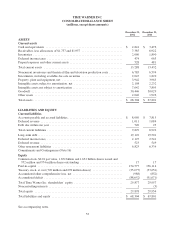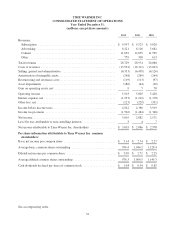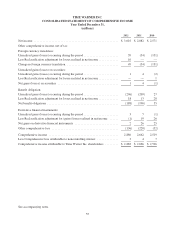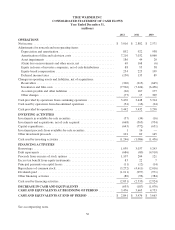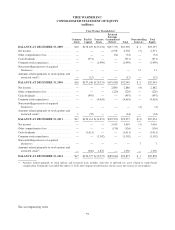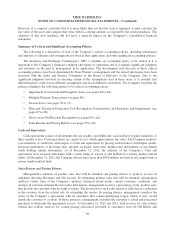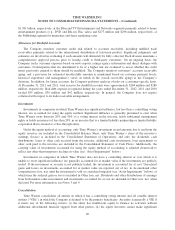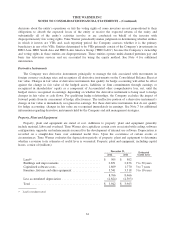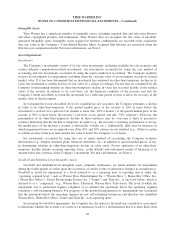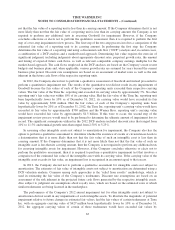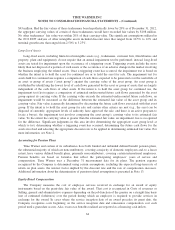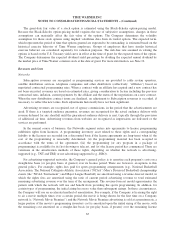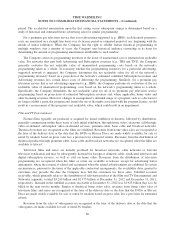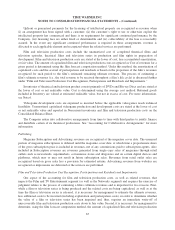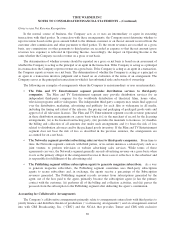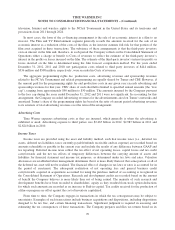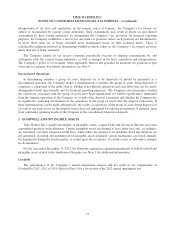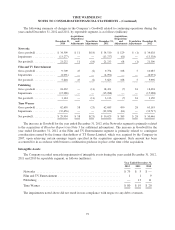Time Magazine 2012 Annual Report Download - page 79
Download and view the complete annual report
Please find page 79 of the 2012 Time Magazine annual report below. You can navigate through the pages in the report by either clicking on the pages listed below, or by using the keyword search tool below to find specific information within the annual report.TIME WARNER INC.
NOTES TO CONSOLIDATED FINANCIAL STATEMENTS – (Continued)
not that the fair value of a reporting unit is less than its carrying amount. If the Company determines that it is not
more likely than not that the fair value of a reporting unit is less than its carrying amount, the Company is not
required to perform any additional tests in assessing Goodwill for impairment. However, if the Company
concludes otherwise or elects not to perform the qualitative assessment, then it is required to perform the first
step of a two-step impairment review process. The first step of the two-step process involves a comparison of the
estimated fair value of a reporting unit to its carrying amount. In performing the first step, the Company
determines the fair value of a reporting unit using a discounted cash flow (“DCF”) analysis and, in certain cases,
a combination of a DCF analysis and a market-based approach. Determining fair value requires the exercise of
significant judgment, including judgments about appropriate discount rates, perpetual growth rates, the amount
and timing of expected future cash flows, as well as relevant comparable company earnings multiples for the
market-based approach. The cash flows employed in the DCF analyses are based on the Company’s most recent
budgets and business plans and, when applicable, various growth rates are assumed for years beyond the current
business plan period. Discount rate assumptions are based on an assessment of market rates as well as the risk
inherent in the future cash flows of the respective reporting units.
In 2012, the Company elected not to perform a qualitative assessment of Goodwill and instead proceeded to
perform a quantitative impairment test. The results of the quantitative test did not result in any impairments of
Goodwill because the fair values of each of the Company’s reporting units exceeded their respective carrying
values. The fair value of the Time Inc. reporting unit exceeded its carrying value by approximately 7%. No other
reporting unit’s fair value was within 10% of its carrying value. Had the fair value of the Time Inc. reporting unit
been hypothetically lower by 10% as of December 31, 2012, its carrying value would have exceeded its fair
value by approximately $300 million. Had the fair values of each of the Company’s reporting units been
hypothetically lower by 20% as of December 31, 2012, the Time Inc. reporting unit’s carrying value would have
exceeded its fair value by approximately $700 million and the Warner Bros. reporting unit’s carrying value
would have exceeded fair value by approximately $1.3 billion. If this were to occur, the second step of the
impairment review process would need to be performed to determine the ultimate amount of impairment loss to
record. The significant assumptions utilized in the 2012 DCF analysis included discount rates that ranged from
10% to 11.5% and terminal growth rates that ranged from 2.50% to 3.25%.
In assessing other intangible assets not subject to amortization for impairment, the Company also has the
option to perform a qualitative assessment to determine whether the existence of events or circumstances leads to
a determination that it is more likely than not that the fair value of such an intangible asset is less than its
carrying amount. If the Company determines that it is not more likely than not that the fair value of such an
intangible asset is less than its carrying amount, then the Company is not required to perform any additional tests
for assessing intangible assets for impairment. However, if the Company concludes otherwise or elects not to
perform the qualitative assessment, then it is required to perform a quantitative impairment test that involves a
comparison of the estimated fair value of the intangible asset with its carrying value. If the carrying value of the
intangible asset exceeds its fair value, an impairment loss is recognized in an amount equal to that excess.
In 2012, the Company elected not to perform a qualitative assessment for intangible assets not subject to
amortization. The estimates of fair value of intangible assets not subject to amortization are determined using a
DCF valuation analysis. Common among such approaches is the “relief from royalty” methodology, which is
used in estimating the fair value of the Company’s tradenames. Discount rate assumptions are based on an
assessment of the risk inherent in the projected future cash flows generated by the respective intangible assets.
Also subject to judgment are assumptions about royalty rates, which are based on the estimated rates at which
similar tradenames are being licensed in the marketplace.
The performance of the Company’s 2012 annual impairment test for other intangible assets not subject to
amortization did not result in any impairments of such intangible assets. To illustrate the magnitude of potential
impairment relative to future changes in estimated fair values, had the fair values of certain tradenames at Time
Inc. with an aggregate carrying value of $627 million been hypothetically lower by 10% as of December 31,
2012, the aggregate carrying values of certain of those tradenames would have exceeded fair values by
63


